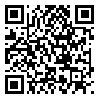BibTeX | RIS | EndNote | Medlars | ProCite | Reference Manager | RefWorks
Send citation to:
URL: http://salmandj.uswr.ac.ir/article-1-268-en.html
Objectives: The purpose of this study was to investigate the effect of 4-weeks rehabilitation, electrotherapy and kinesiotherapy programs on range of motion shoulder pain in men with idiopathic frozen shoulder.
Methods & Materials: This was a semi experimental study on 18 patient (Means±SD Age 56.4±6.7 year, height 175.1±5.3 cm, weight 73.1±7.5 kg, history patient 9.2±5.1 month) who referred to the ilam city clinical. The inclusion criteria were male cender, being affected with idiopathic frozen shoulder, considerable loss of activity and existence of nocturnal pain as well as pain in shoulder joint during activity. The exclusion criteria were: Being affected with secondary frozen shoulder, experience of illness and affective field damages in patients with frozen shoulder and previous history of using any treatment plan related to frozen shoulder. Instruments research were personal information questionnaire, visual analogue scale (VAS) and goniometr. After selecting subjects and doing primary pain test and measuring the range of motion rehabilitation programs about 1 hours per day for 4-weaks including electrotherapy (50 minutes) and kinesiotherapy (60 minutes) programs performed regularly. For analysing data used t-tests.
Results: The results of this study showed that shoulder pain after doing 4-weeks rehabilitation exercises had decreased significantly (P<0/05). But affected persons still had painboth when active and in rest, and the pain did not cure completely. The result in post test showed that range of shoulder movement in flextion, abduction, internal and external rotation had improved significantly (P<0/05). Although limitation of shoulder movement in affected person didn’t improve completely. The result in post-test also showed that rang of motion of joint shoulder in flextion (49.4±21.2), abduction (42.8±15.6), internal (22.6±10.6) and external (28.3±10.4) rotation have been improved.
Conclusion: With regard to those findings, it can be concluded that execution and accomplishment of a 4-week rehabilitation, electrotherapy and kinesiotherapy programs had decreased shoulder pain and improved significantly shoulder flexion, abduction, internal and external rotation’s range of motion in patients with frozen shoulder. Therefor, patients who have encountered pain and reduced shoulder range of motion can use the abovementioned rehabilitation programme efficiently and appropriately.
Received: 2010/06/10 | Accepted: 2010/08/20 | Published: 2010/10/01
| Rights and permissions | |
 |
This work is licensed under a Creative Commons Attribution-NonCommercial 4.0 International License. |





